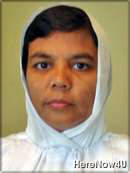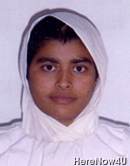 |  |
| Samani[51] Prasanna Pragya[44][52] | Samani[51] Rohit[49] Pragya[44] |
Workshop on Acharya[2] Hemachandra[28][3]’s Yoga[72]-Shastra[60] Dec 18-19, 2011 in South London[34]
During their stopover in London[34] as part of their European tour, Samanijis Prasanna Pragya[44] and Rohit[49] Pragya[44] conducted a private workshop on Acharya[2] Hemachandra[28][3]’s Yoga[72] Shastra[60] at the residence of Shruti & Shailesh Malde in South London[34] on the Saturday - Sunday, 18th -19th December 2010. In spite of heavy snowfall that day, they reached South London[34], and the workshop went ahead with an eager audience of six very keen shravaks[62], Jyotsna Samji, Trusit Shah, Vinay[71] Shah, Jyotsna Shah who also braved the snow to get there, and of course the hosts, Shruti and Shailesh Malde. Strangely, this workshop coincided with the International Seminar on Yoga[72] Shastra[60][73] of Hemachandra[28] Acharya[2] and homage to Late Rev Muni[38] Jambuvijay held at the same time 18-19 Dec at Bhogilal Leherchand Institute of Indology[13] in New Delhi[18][39]!
This particular text was selected as a topic of study by Shruti because Acharya[2] Hemachandra[28][3] is very well known as a versatile genius from the 12th century, who has produced various well known literary works which has earned him the honorific title Kalikal Sarvagna, “The Omniscient[42] of the Degenerate Age”. Acharya[2] Hemachandra[28][3] was instrumental in converting King Kumarpal to Jainism[30] and introducing Vegetarianism[70] especially during the festival of Paryushan[43] in Ahmedabad[9]. On the request of the King Kumarpal, Acharya[2] Hemchandra[4] wrote Yoga[72]-Shastra[60], which is a famous treatise on yoga[72]. The Yoga[72]-Shastra[60] and its voluminous auto-commentary, the Svopagyavritti, is the most comprehensive treatise on Shvetambar[66] Jainism[30] known to us, and although considered as a handbook, sadly it seems only to be discussed in few academic circles of today. Acharya[2] Hemachandra[28][3] uses the ratnatraya[48] – correct belief (darshan[17]), knowledge (gnan), and conduct (charitra[16]) - as an organising principle in the Yoga[72]-Shastra[60]. It beautifully covers aspects of Jainism[30], the five major vows, the mahavrattas of the ascetics, five samitis[55] and three guptis[24] (the ashtapravachan matas), twelve shravak[61] vows, twelve contemplations (bhavanas[12]) with apt examples and elaboration on meditation[36]. Acharya[2] Hemachandra[28][3]’s account of Jainism[30] consists of systematic presentation of ideas and practices from the Shvetambar[66] canonical scriptures (shruta) and the tradition (sampraday[56]) and moulded into a coherent whole with ideas used from other Jain acharyas[6] before him like Umasvati and Haribhadra[26] as well as the non-Jain Pan-Indian ideas of Shaiva and Tantric traditions.
Each day started and finished with mangal-path. On Saturday, Samaniji Prasanna Pragya[44] explained that the Yoga[72]-Shastra[60] was dear to Acharya[2] Mahapragya[35][5] and he had recommended all Samans[53] / Samanijis to read it at least once. Samaniji Rohit[49] Pragya[44] had studied and used the initial four chapters as part of her thesis regarding the twelve vows. To present the workshop, she revisited the text and studied it in its entirety. Her understanding and method of explaining with relevant examples and allusions to clarify the subject is thoroughly commendable. After giving a lucid introduction to Acharya[2] Hemachandra[28][3], she explained that yoga[72] in Jainism[30] was equivalent to samadhi[50] / samyaktva[57] or equanimity[21] and then shecleverly brought out the subtlety in Acharya[2] Hemachandra[28][3]’s style of linking the subject matter of each chapter, and leading to the goal of purification of the Self. It starts with briefly defining darshan[17] and gnan and then elaborating on charitra[16] (conduct) by defining it with examples of the mahavrattas of the ascetics and the twelve shravak[61] vows and daily routine of an exceptional layman which is covered by the first three chapters.
The second day started with discussion from chapter four and carried on until the last and the final chapter, twelve. Having defined the goal as the purification of the Self, the passions which arise from uncontrolled sensual activities and their effects are explained, and these are the root cause of our miseries and transmigration. After controlling the senses, one can contemplate on the twelve bhavanas[12] to purify the mind and prepare for meditation[36], with some elaboration on yogic postures. Chapter five is the most voluminous chapter and delves in divination and occult practices which are condemned in early Jain scriptural texts, but during the medieval period, Jainism[30] was influenced by Tantrism. Later chapters deal with discussing details of breath control, which in effect will help to control the mind which can help in achieving pure meditation[36]. The four methods of meditation[36] are explained as, pindastha, padastha, rupastha and rupatita. Finally, the highest meditation[36], shukla[64] dhyana[20][65] is explained and how it can be achieved. One can only attain liberation, Moksha[37] after experiencing shukla[64] dhyana[20][65]. However, according to the scriptures, one cannot achieve this from Bharat Kshetra[32] in the current period. Having portrayed systematically what the scriptures say and also ideas borrowed from other traditions, the final chapter is Acharya[2] Hemachandra[28][3]’s views, and he says that one has to recognise the four states of mind and ascend to the highest state to experience the pure Self. Acharya[2] Hemachandra[28][3] also emphasises the importance of a true guru[25] to achieve this.
As one my dear friends expressed, it was a truly spiritually uplifting weekend and we are very grateful to Samanijis Prasanna Pragya[44] and Rohit[49] Pragya[44] for giving us insight and opportunity to acquaint us with Hemachandra[28]’s Yoga[72]-Shastra[60]. We would now wish to conduct an in-depth study.
References
Qvarnstrom, Olle (2002). The Yoga[72]śāstra of Hemacandra[27][69]: A Twelfth Century Handbook on Śvetāmbara[74] Jainism[30], Cambridge, Massachusetts: Dept of Sanskrit[58] Studies, Harvard University.
Gopani, A. S. (Translator), Bothara, Surendra (Editor) (1986). The Yoga[72] Shastra[60] of Hemchandracharya (A 12 th century guide to JainYoga), Jaipur[31]: Prakrit[45] Bharat Academy
Brief synopsis of each chapter
The first chapter details the importance of yoga[72] and lists the five great vows - Ahimsa[8], satya[59], Achaurya[7], Brahmacharya[15] and Aparigraha[10]. It also explains eight spiritual matrices (ashta pravachan[47] mata) i.e. five types of disciplines (samiti[54]) and three types of control (gupti[23]). It also details the social duties of a disciplined house holder.
The second chapter explains about dev, guru[25] and dharma[19], characteristics (lakshana[33]) and faults (dushana) of samyaktva[57], five small vows etc.
The third chapter describes supplementary vows (gunvrats and shikshavrats) and transgressions of all vows of householders.
The fourth chapter is devoted to the definition of body[14], soul[67], knowledge, passions etc. It details methods for disciplining the mind, the discussion transcends to feelings and how to practice equanimity[21]. It also gives a brief description of yogic postures.
The fifth chapter talks about pranayam[46] and its effects. Also included are the occult sciences, astrology etc.
The sixth chapter emphasise on focusing of the mind on particular places of body[14] to attain tranquillity.
The seventh chapter classifies higher meditation[36] into four stages - pindastha, padastha, rupastha and rupatita (one which is confined to body[14], to mystic syllables, to divine form and to the formless) and details about the first stage.
Eighth chapter explains the second stage of meditation[36] which is mainly based on sounds and mantras.
Ninth chapter contains the third stage of meditation[36] which is concentrating on the image of the omniscient[42].
Tenth chapter deals with the fourth stage of meditation[36] where there is no dependence on physical objects or sounds or images.
The eleventh chapter goes into details of the pure meditation[36] and its levels leading to emancipation. This concludes the traditional Jain yoga[72][29].
In the twelfth chapter, explaining his own experience, Acharya[2] Hemchandra[4] says about four states mind - Vikshipta (distorted or distracted), Yatayata (ambivalent), Shlishta (stable), and Suleen (engrossed).
Om[40] Arham[11]
Shruti Malde[63]